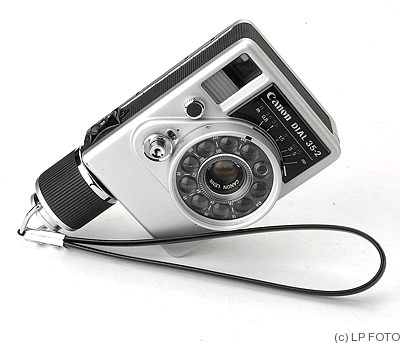Don't forget to update your personal camera inventory
Canon: Dial 35 II
CollectiBlend Average Index
| ||||||||||||
| Camera rarity | ||||||||||||
Searching eBay listings: 
1968-1971. 35mm half-frame camera. Updated Dial 35.

Camera featured in these collections: mobilene bh3o81 tomidery jerryf mauro.corneo![]() bill339
bill339![]() rytchy77 fotobis Badsalar
rytchy77 fotobis Badsalar![]() timfable
timfable
converted and inflation-adjusted prices:
| Condition | Price | |||
| 2013-06-15 | $172 | |||
| 2011-09-25 | $155 | |||
| 2010-02-06 | $78 | |||
| 2009-10-25 | $206 | |||
| 2009-10-25 | $225 | |||
| 2009-06-07 | $162 | |||
| 2009-06-07 | $171 | |||
| 2007-09-16 | $113 | |||
| 2003-02-28 | $138 | |||
Post a reply
The eye-catching Dial 35 (1963 to 1967) and Dial 35-2 (1968 to 1971) had unique user-appeal and makes a good conversation piece. Half-frame cameras were in vogue in the early-to-mid 1960’s and were then predicted to supersede full-frame 35mm. Canon’s imaginative design offered motorized film transport and landscape format orientation as well as automatic exposure. But the Dial 35’s landmark features were more for show than go. The telephone-style ‘dial’ rotated when either the shutter speed (1/30 of a second to 1/250 of a second) or the film speed was set by the user, positioning one or other dial ‘lens’ (each had a different internal aperture) over the CDS cell. These adjustments were in full-stop increments only, intermediate film speed settings could not be made. Although the dial looked intriguing it was impractical. The ASA markings were too vague and obscure. Films between ‘ranges’ - 40, 100, 180 or 320 ASA – would have to have been half a stop over- or under-exposed throughout. The 49mm filter mount allowed filters to cover the whole dial and meter cell. Aperture setting was automatic, f-stops shown in the bright-frame viewfinder, with a manual override facility. The 28mm, 5-element f2.8 lens gave a useful field of view equivalent to 40mm on full-frame. Depth of field was thought sufficient for zone-focusing only, which was effected with a lever above the lens barrel, the zone being indicated in the viewfinder. The clockwork motor, which also rewound the film, was wound up by turning the cylindrical handle, grip provided by a ribbed rubber surround. An accessory shoe was inset at the side of the body. A tripod and cable-release sockets were provided, but no “B” shutter setting. The Dial 35, with its quality lens and reliable automatic exposure produced good results. The film transport mechanism is a weak point, and examples still in working order are unusual. The necessity of motor wind in a snapshot camera is debatable, it did lead to more shots being taken, an indirect benefit perhaps with half-frame, which needed up to 75 exposures to finish up a roll of film. The Dial 35-2 camera had an improved clockwork motor and a hot-shoe and was marketed in the USA as a Bell and Howell Dial 35 (1967 to 1972).
Searching eBay listings: 
Searching other listings: 
Icons legend: